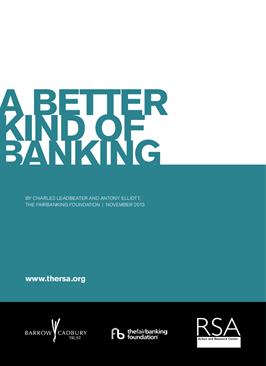The report reveals, in very practical terms, how the deeply troubled financial sector could be transformed by learning from the commercial insurgents banging on the gates of the banking fortress. These companies and initiatives are tiny when compared financially to the behemoths controlling global banking but they are giants in terms of creativity and customer care.
For too long the culture and values of the banks encouraged managers to pursue profits at the expense of their customers’ interests. Banks have an asymmetrical relationship with customers: bankers know a lot more than their customers about the complex products and services they offer.
An inappropriate retail culture meant bank staff were rewarded for selling customers products they neither fully understood nor needed. Banks will not change fundamentally unless they resist exploiting this asymmetry and instead treat their customers with greater restraint, responsibility and respect.
Nothing is fixed in stone. There are alternatives to this dominant but flawed approach.These alternatives can show banks can make a decent commercial rate of return with very different approaches, in which they work with customers to enable them to manage their money more carefully and intelligently.
pdf 196.4 KB
Contributors


The FairBanking Foundation
Related reports
-
Make it authentic: Teacher experiences of youth social action in primary schools
Nik Gunn Aidan Daly Mehak Tejani
Youth social action brings all sorts of benefits to young people and communities. But how do teachers experience it? And what can we learn from that experience?
-
Preventing school exclusions: collaborations for change report
Mehak Tejani Benny Souto Aidan Daly
School exclusion can change the course of a young person’s life. It can have long-term implications for their health, wellbeing, and future opportunities.
-
Digital innovations in lifelong learning: a global perspective
Veronica Mrvcic James Richardson Amy Gandon Aoife O'Doherty
Digital innovations in lifelong learning: a global perspective explores the drivers that support and the barriers that limit the international reach and impact of digital lifelong learning innovations.



